1st April 2013 – Marabá
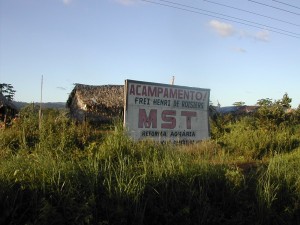 I am here in Marabá, Pará, Brazil, on behalf of Trident Ploughshares as part of a 3 person Right Livelihood Award (RLA) delegation. We are here to express our solidarity with two other RLA laureates – the Landless Workers Movement (MST) – who have had 2 of their leaders murdered in the last 2 months and the Pastoral Land Commission (CPT) who have had their offices attacked 3 times already this year and whose leaders have received death threats. This violence and intimidation is unfortunately very common here in Brazil and together with inadequate police investigations and frequent delays in judicial proceedings contributes to the sense of impunity.
I am here in Marabá, Pará, Brazil, on behalf of Trident Ploughshares as part of a 3 person Right Livelihood Award (RLA) delegation. We are here to express our solidarity with two other RLA laureates – the Landless Workers Movement (MST) – who have had 2 of their leaders murdered in the last 2 months and the Pastoral Land Commission (CPT) who have had their offices attacked 3 times already this year and whose leaders have received death threats. This violence and intimidation is unfortunately very common here in Brazil and together with inadequate police investigations and frequent delays in judicial proceedings contributes to the sense of impunity.
Brazil has one of the most inequitable distributions of land ownership in the world. Two per cent of its landowners hold 60 per cent of its arable land. This inequality is one of the main causes of violence. Some 90 million people, two thirds of the population, are landless peasants or slum dwellers excluded from land by this concentration of ownership. Their conditions of life are among the worst in the world: high infant mortality, millions of destitute street children in the cities and, in the countryside, situations sometimes akin to slavery, where workers are controlled by the landlord’s hired gunmen.
Those who seek to organise to challenge this situation risk much with beatings, death threats and intimidation being commonplace. Yet despite scores of farmers, priests, social workers and Indians killed every year, only a handful of murder cases have ever come to trial (1).
From 1979 local groups began to be formed through the struggles in the countryside and in 1985 they founded the Movimento dos Trabalhadores Rurais Sem Terra, the LandlessWorkers’ Movement (MST) a 1991 Right Livelihood Award recipient. It was formed as a mass movement inside the trade union movement with the aim of struggling for land for its members. The formation of MST was encouraged and assisted by the Commissâo Pastoral da Terra, CPT (also a 1991 Right Livelihood Award recipient).
One of MST’s slogans is ‘Occupy, Resist, Produce’. As a grassroots socialist organisation,MST promotes land reform as a means of achieving social equality for landless rural farmers. It organises occupations of unproductive land, on the basis of which it negotiates with the state or federal authorities to transfer that land to the peasants. The occupying campesinos work the land productively, providing an escape from poverty and providing them with a dignified, selfsufficient existence. MST then invites the government to take the next step — formalising the settlements and providing education, health and other services.
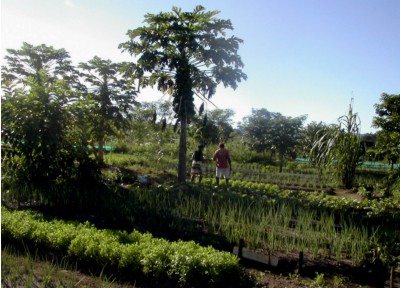
MST supports the farmers in forming agricultural cooperatives to produce effectively in competition with the big estates. Over almost three decades, this movement of landlessrural workers has won an area the size of Sweden to settle almost a million families and is using organic methods in a country that is the world’s largest user of (2) agrochemicals.
Today, we visited the Head Office of MST in Para and heard first hand about the situation in Brazil and in Pará. The State of Pará is the second largest Brazilian state with an area of over 1.2 million square kilometres. It is one of the most biodiverse areas in the world, though this is rapidly changing with the deforestation that is taking place. It is the greatest producer and exporter of wood in the Brazilian Amazon region, meeting 40% of production and 60% of all exports in all the Amazon states. This region accounts for more than a third of total deforestation in Brazil due to illegal deforestation and land occupation, mostly due to cattle ranching and soya farming. The conflicts between government, indigenous tribes, landless peasants and ranchers over land rights are exacerbated by the demand for beef,soya, timber and minerals from Europe and China amongst other places.
Slavery is a major problem in Pará. During 2003, 60% of all workers freed in Brazil were (3) from Pará . Pará also has one of the highest indices of public and private violence against social movements. We were shocked to hear that 4 of the MST organisers talking to us were on the ‘death list’ as they call those who have had death threats issued to them. It is in this state that 19 landless workers were assassinated in 1996, known as the massacre of Eldorado de Carajás.
We heard a great deal about this terrible massacre from one of the survivors, Ivagno, who had been 14 at the time, and is now one of the National Board members of MST. 5000 landless peasants had camped on unproductive ranch land and were planning in 1996 to march to Belém, the capital of Pará, to ask that the land be given to them. Instead of negotiating with the people, the Government sent the military police, who corralled the people on an ‘S’ bend on the highway and shot dead 19 people and severely injured 79,many of whom are now permanently disabled. The police had been ordered to clear the highway ‘at any cost’.
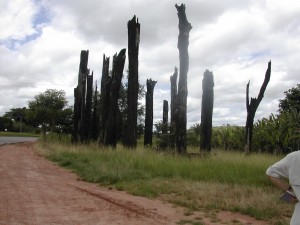 Ivagno took us to the notorious ‘S’ bend and (4) showed us the memorial to the massacre.The killings and injuries have left the community traumatised.A year after the massacre, the government allowed the camp to become a settlement for 690 families on 18,000 hectares.
Ivagno took us to the notorious ‘S’ bend and (4) showed us the memorial to the massacre.The killings and injuries have left the community traumatised.A year after the massacre, the government allowed the camp to become a settlement for 690 families on 18,000 hectares.
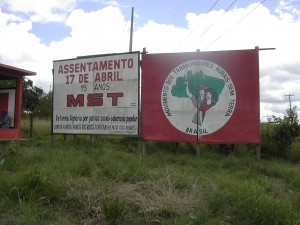 We visited the settlement and were pleased to see a vibrant village with internet cafe, school and health clinic, clear proof of the ability of peasants to provide for themselves when given access to land. The land had been deforested by the cattle ranchers but was slowly recovering and being planted up and you can see the trees beginning to grow taller beyond the gym where the school children are exercising.
We visited the settlement and were pleased to see a vibrant village with internet cafe, school and health clinic, clear proof of the ability of peasants to provide for themselves when given access to land. The land had been deforested by the cattle ranchers but was slowly recovering and being planted up and you can see the trees beginning to grow taller beyond the gym where the school children are exercising.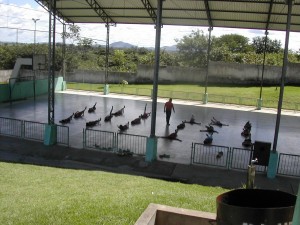
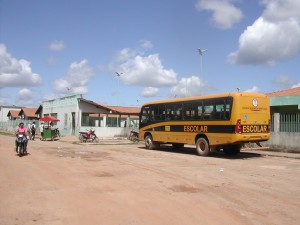 Schools and education are a major part of the process of land occupation and settlement.This was made clear when we visited land that had been occupied by MST 3 years ago at the Frei Henri encampment.
Schools and education are a major part of the process of land occupation and settlement.This was made clear when we visited land that had been occupied by MST 3 years ago at the Frei Henri encampment.
MST encourage all the people to work and
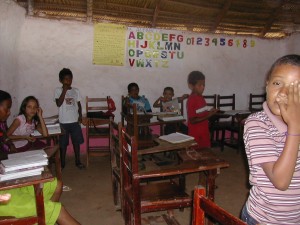 to educate themselves and schools are set up immediately for the children during the day and for adults for literacy classes in the evenings.
to educate themselves and schools are set up immediately for the children during the day and for adults for literacy classes in the evenings.
Help is provided by MST to encourage good community processes of decision making and also by providing tools and advice on
how to become productive food growers.We were very impressed with the amounts of vegetables and fruits grown by the families.Papaya,bananas, corn, cassava, beans,onions, coriander, chillies to name just a few.
We were told of the violence last November when the rancher who felt he ‘owned’ the land,even though it was originally ‘public’ land available for land redistribution, had fired shots into the camp. A 30 day ‘war’ started with a great deal of intimidation and shooting from the hill into the gardens. In self defence, some of the farmers told us, they had organised themselves, built a wall around the camp and made hand made weapons, that they shot in the air to show they were willing to defend themselves. They think this is what stopped the violence along with informing the rural conflict police and human rights organisations.
They are working hard with MST, trying to get the Government to send INCRA (Brazil’s national Institute for Colonisation and Agrarian Reform) technicians to survey the land and camp in order to get the land transferred to them.
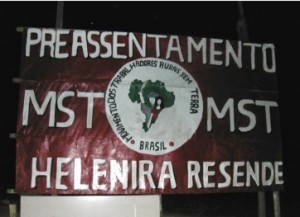 It was getting dark as we entered the last encampment – Helenira where 150 families have been encamped for 3 years. They have occupied 65 hectares of land that had been bought up by the Santa Barbara Group who had taken 14,000 hectares of which MST claim at least 6,000 hectares is public land and therefore to be available for land reform. They have built their houses from local materials – mud, wood, palm leaves and grow their food and live in hope that the government will send officials to survey the land and allow them to settle there. MST provide the pressure on the government officials to enable this to happen.All the people we saw were living productive, creative lives with happy children, learning in their own schools that they had built themselves. What a contrast to the lives they were living before!
It was getting dark as we entered the last encampment – Helenira where 150 families have been encamped for 3 years. They have occupied 65 hectares of land that had been bought up by the Santa Barbara Group who had taken 14,000 hectares of which MST claim at least 6,000 hectares is public land and therefore to be available for land reform. They have built their houses from local materials – mud, wood, palm leaves and grow their food and live in hope that the government will send officials to survey the land and allow them to settle there. MST provide the pressure on the government officials to enable this to happen.All the people we saw were living productive, creative lives with happy children, learning in their own schools that they had built themselves. What a contrast to the lives they were living before!
This day gave us an introduction to the background of the landless movement and the violence and intimidation that surround not only the organisers but also the peasants themselves. Tomorrow, at the University of Pará we will learn more.
Notes
1. 2005 FIDH Report – There are serious violations to civil and political rights that persist throughout the country, in particular the practice of summary, arbitrary or extrajudicial executions, torture and arbitrary detentions involving police and staff in prisons. The majority of deaths perpetuated by the police are due to illegal activity carried out by police officers, due to abuse of lethal power during confrontations or due to the summary executions of civilians.Torture is carried out at police head- quarters, in prisons, and detention centres.
2. From http://www.mstbrazil.org/news/occupy-brazil-landless-dig-ditch-pesticides – Brazil is the world’s biggest consumer of agrochemicals, with each citizen ingesting an average of 5.2 litres of pesticides each year. Indeed, the International Assessment of Agricultural Knowledge, Science and Technology for Development (IAASTD), an initiative set up by the World Bank and the United Nations in 2002, shares this concern in its 2009 report on Latin America and the Caribbean. “The health of rural communities in LAC [Latin America and the Caribbean] has been detrimentally affected by problems of acute and chronic intoxications in the countryside due to the indiscriminate use of agrochemicals,” the report reads.
3. http://www.bbc.co.uk/news/10230766 – 26 June 2010 Forced labour clouds boom in Brazil’s Amazon by Vladimir Hernandez BBC Mundo, Para, Brazil. “Business is booming in Maraba, a small town in the Brazilian Amazon. The region’s cattle farming, charcoal and logging industries are attracting jobseekers from all over Brazil. But there is still slave labour. In the state of Para government officials say that over the past two years they have rescued more than 1,000 workers who were being held on farms or in charcoal camps against their will. Ranchers often exert their economic influence with powerful people to avoid investigations when allegations of slave labour are made. Several land activists have been killed in recent years, as well as government officials who investigate allegations of abuse by ranchers. Jose Batista from the Pastoral Land Commission says that ranchers often exert their economic influence with powerful people to avoid investigations when allegations of slave labour are made. The ranchers themselves say that slave labour “does not exist” in Para.”
4. A Welsh artist, named Dan Baron Cohen, constructed this memorial that consists of 19 burnt trees to symbolise not only the murder of the 19 peasants but also the destruction of the forest.
Background info on Angie Zelter’s visit to Brazil as a representative of Trident Ploughshares:
Right Livelihood Award Laureates Solidarity Mission to Landless Workers in Brazil
Download Angie’s report from Maraba in Pdf
